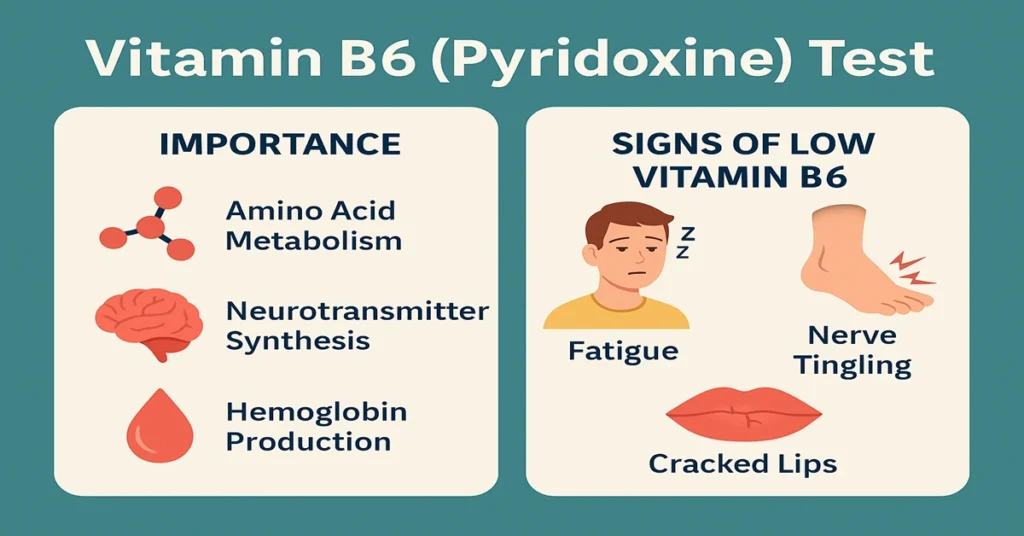What is Vitamin B6?
Vitamin B6, also known as Pyridoxine, is a water-soluble vitamin that is part of the B-complex group.
It plays a vital role in protein metabolism, nervous system function, hemoglobin production, and neurotransmitter synthesis.
Vitamin B6 exists in several active forms — pyridoxal, pyridoxamine, and pyridoxal phosphate (PLP) — each performing different but important roles in the body.
It helps maintain proper brain function, regulate mood, and keep the immune system strong.
Because the body cannot store or synthesize Vitamin B6, it must be supplied daily through food or supplements.
Where is Vitamin B6 Produced or Synthesized?
- The human body cannot make Vitamin B6 on its own.
- It must come from dietary sources such as poultry, fish, whole grains, potatoes, bananas, nuts, and chickpeas.
- Small amounts of Vitamin B6 are produced by intestinal bacteria, but this production is not sufficient to meet daily requirements.
Thus, a healthy and balanced diet is necessary to maintain optimal Vitamin B6 levels.
Main Functions and Importance of Vitamin B6
Vitamin B6 is essential for multiple body processes.
Here are its main functions:
1. Amino Acid Metabolism
It helps the body break down proteins and use amino acids efficiently, which is essential for muscle repair and overall body growth.
2. Neurotransmitter Synthesis
Vitamin B6 helps produce key brain chemicals (neurotransmitters) such as serotonin, dopamine, and GABA.
These control mood, sleep, and brain function — hence, low B6 may cause mood swings, anxiety, or depression.
3. Hemoglobin Production
It supports the formation of red blood cells (RBCs) and is important for hemoglobin synthesis, which carries oxygen throughout the body.
4. Immune System Support
Vitamin B6 plays a role in antibody formation, helping the body fight infections and maintain a strong immune response.
5. Glucose Regulation
It helps convert stored glycogen in the liver into glucose, which provides energy during fasting or exercise.
6. Hormonal Regulation
It assists in balancing hormones and can help reduce PMS (premenstrual syndrome) symptoms in women.
Causes of Low Vitamin B6 Levels (Deficiency Causes)
Vitamin B6 deficiency can occur due to several factors, especially in people with poor diet or medical conditions.
Common causes include:
- Poor dietary intake or malnutrition (low protein and vitamin intake).
- Chronic alcoholism, which reduces absorption and metabolism.
- Certain medications, such as isoniazid, hydralazine, and penicillamine (used for tuberculosis, hypertension, etc.).
- Kidney failure requiring dialysis, which causes vitamin loss.
- Genetic enzyme defects that interfere with B6 metabolism (rare).
Symptoms of Vitamin B6 Deficiency
Deficiency of Vitamin B6 affects the nervous system, skin, and blood.
Symptoms may include:
- Fatigue, weakness, or irritability
- Depression, anxiety, or confusion
- Cracks at the corners of the mouth (cheilitis)
- Swollen, sore tongue (glossitis)
- Peripheral neuropathy – tingling or numbness in hands and feet
- Microcytic anemia – small red blood cells due to poor hemoglobin formation
- Severe cases: Seizures, especially in infants or elderly individuals
If left untreated, these symptoms can worsen and affect brain and nerve function over time.
Causes of High Vitamin B6 Levels
High levels are uncommon from food sources, but can occur due to:
- Excessive supplementation, especially more than 100 mg/day
- Multiple overlapping supplements (such as B-complex + multivitamins together)
Normal food intake alone cannot cause toxicity since Vitamin B6 is water-soluble and the body excretes excess through urine.
Symptoms of Vitamin B6 Toxicity (High Levels)
Taking very high doses for long periods can cause nerve damage (sensory neuropathy).
Typical signs of toxicity include:
- Numbness or burning sensation in hands and feet
- Loss of coordination or balance problems
- In severe or prolonged cases, nerve damage may become irreversible
Therefore, supplementation should only be taken under medical advice.
Reference Range (Normal Blood Levels)
| Parameter | Normal Range |
|---|---|
| Vitamin B6 (Pyridoxine) | 20 – 125 nmol/L (may vary slightly by lab) |
Levels below 20 nmol/L indicate deficiency, while higher levels usually result from supplement overuse.
Sample Type and Test Method
- Sample type: Blood (plasma or serum)
- Test purpose: Measures Vitamin B6 (as pyridoxal phosphate – PLP) concentration.
- Fasting: Usually not required, but your doctor may recommend fasting if other tests are being done simultaneously.
Test Preparation
To ensure accurate results:
- Avoid taking Vitamin B6 supplements for 24–48 hours before testing.
- Inform your doctor about all medications or multivitamins you are using.
- If possible, get the test done in the morning for most stable readings.
- Stay hydrated and relaxed before sample collection.
When to Consult a Doctor
Consult your doctor if you experience:
- Constant fatigue or weakness
- Mood changes such as depression or anxiety
- Numbness, tingling, or burning sensation in the hands and feet
- Cracks near mouth, tongue swelling, or unexplained anemia
Your doctor may recommend:
- Vitamin B6 level testing
- Dietary adjustments
- B-complex supplementation if deficiency is confirmed
Regular monitoring is also important if you take supplements or certain medications that affect vitamin metabolism.
Important Word Explanations
| Word | Meaning |
|---|---|
| Pyridoxine | Scientific name for Vitamin B6. |
| Neurotransmitters | Brain chemicals like serotonin and dopamine that control mood and nerves. |
| Cheilitis | Cracks or sores at the corners of the mouth. |
| Glossitis | Swelling and redness of the tongue. |
| Peripheral Neuropathy | Nerve damage causing tingling or numbness in hands and feet. |
| Microcytic Anemia | A type of anemia with small-sized red blood cells. |
~END~

